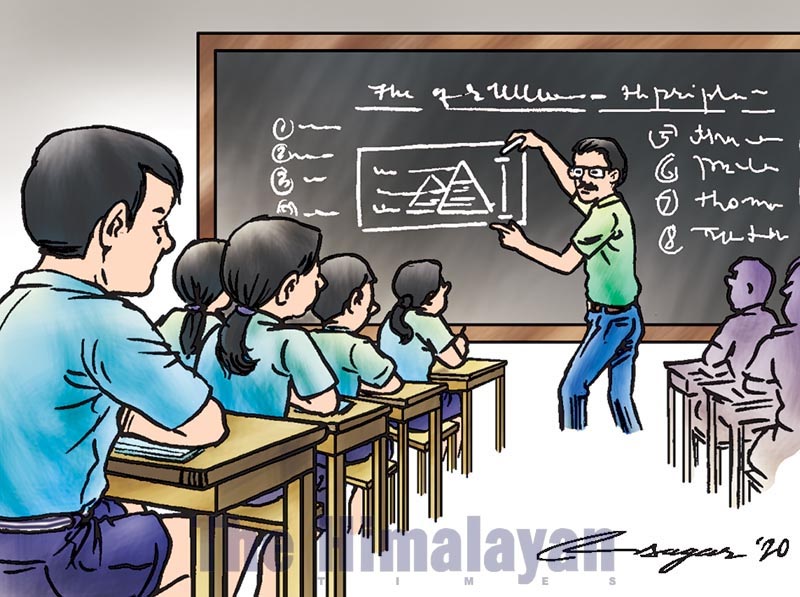A nation at risk: Invest heavily in education
Nepal invests only 3.7% of GDP in education, which is lower than those developing economies that have now realised the importance of investing in education, such as Ethiopia (4.5% of GDP), Senegal (7.4%) or Mozambique (6.5%)
The future of our children and our nation is at risk. This is because learning achievement of our children is low and stagnant. The time to bask in the success of enrolling students in schools is over. Robust analyses show stronger positive association of economic growth with learning outcomes than with enrollment.
The OECD recently published the Program for International Student Assessment (PISA 2018) results that measures ‘15-year olds’ ability to use their reading, mathematics and science knowledge and skills to meet real-life challenges’. Some 79 countries participated in the 2018 assessment, and, once again, Singapore, Japan, Korea, regions of China, Finland and Canada were the top performers. These countries have also consistently performed at the top in other internationally benchmarked learning assessments, which help participating countries to better understand areas of their strengths and weaknesses so that curricular and pedagogical adjustments can be made to improve performance.
Nepal does not yet participate in any of these assessments. In the absence of a robust and regularly conducted national assessment system to improve student performance, Nepal’s National Assessment of Student Achievement (NASA) is a proxy and provides some insights into how well our children are learning. The 5th grade mathematics and Nepali assessments that were carried out at the start of 2018 showed that only 28% of students displayed adequate knowledge/skills in mathematics for that grade level, and only 45% of students showed adequate knowledge/skills in Nepali. Wide variations in outcomes were evident across provinces and districts and between school types, among other variables.
In the absence of adequate skills linking our youth to the demands of various economic sectors, it is no surprise that some 3.5 million youth are out of country. And given the archaic higher education system, those who are better qualified are leaving the country for higher education and careers in foreign lands. What will be the consequence of having so many of our youth outside the country?
Most high performing competitive countries have strong human development investment plans and strategies. While the strategies themselves might differ dramatically, three critical elements seem common. First, it is evident that these top performers started their investments in education from their early stages of development. For example, Singapore and Korea started investing significantly in education in the 1970s and 1980s, when their basic enrollment rates were less than ours today. Second, they are persistent investors, investing heavily in education even after they have attained developed economic status. Third, not surprisingly, these countries are also those that are most competitive. Most competitive economies have emphasised the importance of investing in education and human development as a ‘national’ priority. Singapore’s Lee Kuan Yew once said: “Just as a country is as good as its citizens, so its citizens are, really, only as good as their teachers.”
By contrast, Nepal’s investment in the education of our young is grossly inadequate. For example, we invest public funds equivalent to only 3.7% of GDP in education. This is lower than those developing economies that have now realised the importance of investing in education, such as Ethiopia (4.5% of GDP), Senegal (7.4%) or Mozambique (6.5%). In addition, our system is highly inefficient and wasteful, funneling allocations into historically funded mandates and unable to re-prioritise cost-effective new interventions. Results from over 300 randomised control trials in the education sector are now available, and a careful review of these would be a great place to start in drawing up a forward-looking strategy.
Significant investments in infrastructure or other areas of growth will yield low returns in the absence of human capital. Furthermore, strategically, a poorly qualified human resource base is unlikely to be able to engage i n, innovate within, and negotiate with neighbours in key economic sectors, leaving these economic terrains vulnerable to unwanted external influences. Thus, we need a strongly argued and prioritised strategy that addresses at least the following: (a) leap-frogging methods to address the growing chasm in quality of content and pedagogy with middle income and high income countries; (b) large and growing youth depletion; (c) planning for jobs when whole categories of the jobs will be lost to automation, and entirely new skills and competencies will be required; and (d) building higher education centres of excellence for the coming decades with both the depth of relevant specialisations and the breath of interdisciplinary linkages, including focus on liberal arts and humanities to help enhance civility, and intellectual and moral strengths that will enhance the resilience of our society.
Unless Nepal swiftly and significantly invests in innovative and cost-effective education initiatives, we may be handing over a highly vulnerable and risky nation to the next generation. When our mindset is to see education as an expense, our reaction will be to minimise our costs. When it is seen as an investment, the focus will be to maximise our long-term returns.
Joshi is director, Centre for Human Assets at IIDS, Kathmandu






